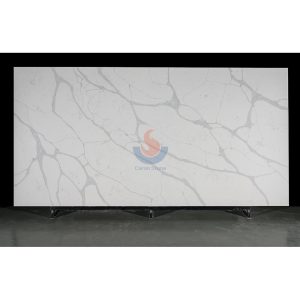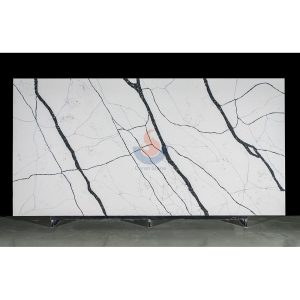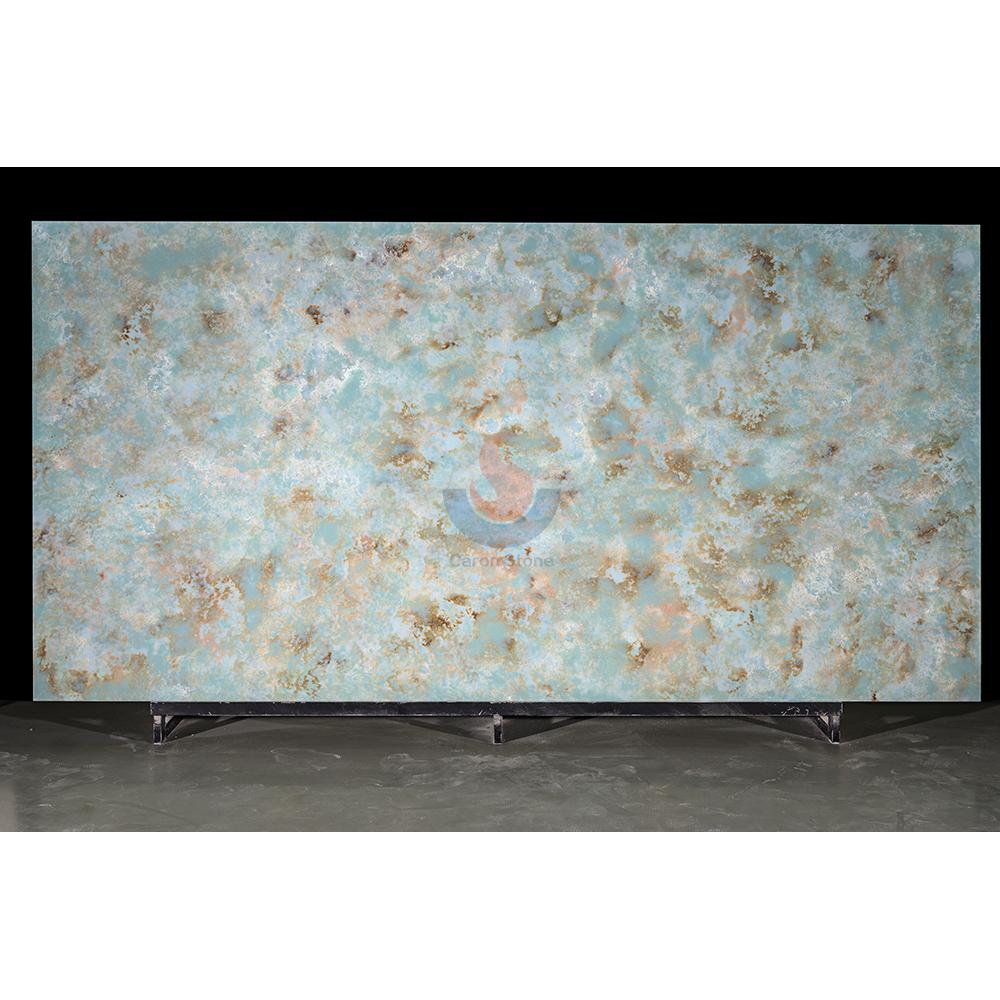One mineral resource with quite constant physical and chemical characteristics is quartz. Nowadays, the plates made by quartz stone producers are shortened as Quartz Stone. It is termed quartz stone since the main component of its plates is quartz content of more than 93%. Quartz stone slabs mostly consist in synthetic raw materials: quartz sand, quartz powder, unsaturated polyester resin, glass particles, color paste, curing agent and coupling agent.

Calacatta White Quartz 47
Artificial quartz stone slabs’ color effect will be directly affected by quartz sand’s transparency and white nature. The same color formula will have great differences in the color effects presented on powders with different whiteness. One may argue that the surface effect of the plate is exactly affected by the contaminants and purity of quartz sand. Right now, fake quartz stone slabs’ sand needs great whiteness criteria. Generally, the whiteness is required to reach more than 90%, and the higher requirement is more than 95%.
The influence of various elements on the quality of quartz stone slabs
The performance of quartz products will be much influenced by elements of impurity in quartz ore. High temperatures will cause transition metals including Cr, Cu, Fe, Ni, Mn, Ti, etc. to change the color of the quartz stone plate, so turning it yellow and influencing the customer’s usage experience. High temperature resistance and thermal properties of the quartz stone plate will be lowered by excessive content of impurities including alkali metal K, Na, Li ions and alkaline earth metal Ca, Mg ions, so lowering the thermal stability and mechanical strength of the quartz stone plate and so producing the final product. It is easy to get scars caused by high temperature or scratched by hard objects.
Two methods exist to prevent the effect of impurity elements on the slabs of fake quartz stone. One is pickling the slab sand; the other is creating slab sand to enhance artificial quartz using premium ores with less impurity elements. Stone slab quality.
Carry out pickling to technically reduce problems such as sandy yellowing of the board after pickling
Difficult to replace with water washing, flotation, magnetic separation and other techniques is the impact and purpose of acid washing. It can effectively remove impurities that exist in the form of inclusions on the surface of quartz sand particles or embedded in the particles. It is a significant technique for treating plates sand. The primary elements influencing the pickling effect in the actual manufacturing process are acidity, time, temperature, acid washing, technology and equipment.
However, some manufacturers said that pickled quartz sand will turn yellow again after being left for a period of time. Mostly the causes are as follows:
(1) There is no magnetic separation process before quartz sand is pickled. Some mechanical iron left in the quartz sand stays after pickling. The mechanical iron is rapidly oxidized, causing the quartz sand to directly turn yellow;
(2) If acid washing is not thorough, residual acid on the surface of quartz particles will also cause yellowing;
(3) Quartz sand comes into contact with transportation tools before drying, causing secondary pollution (oxidation in contact with iron) and turning yellow.
Therefore, in order to prevent the quartz sand from turning yellow, a magnetic separation process must be set up before pickling; acid and alkali-resistant plastic containers should be used for acid leaching equipment; quartz sand should be dehydrated and dried immediately after cleaning; all processing equipment should be well protected , to avoid contact between quartz sand and iron materials.
In addition, the external environment will also affect the effect of pickling. The air environment in manufacturing, packaging, storage, etc. has to be tightly regulated if we are to prevent dust pollution in the air.
Use high-quality ore with few impurities for the production of plate sand
High-quality quartz resources are vanishing as quartz ore is being mined. Most of the quartz ore generated in quartz mines has various contaminants and is covered in yellow complexion. These yellow skin and impurities can be removed at low cost through pickling. Still, acidic compounds will stay on the surface and might not be entirely eliminated from the fissures of quartz particles. These remaining acidic compounds will yellow the surface of white and light-colored artificial stone slabs, therefore influencing the reputation and quality of the products.

Calacatta Quartz 20mm
For this reason, there are still sheet sand enterprises that pick the most traditional sheet sand manufacturing technique, using high-quality vein quartz ore, clean, stable, and high whiteness quartz ore, which just needs to be mechanically crushed and then manually selected and optally sorted. Excellent quartz raw materials are readily available and applied in premium artificial stone slabs.





